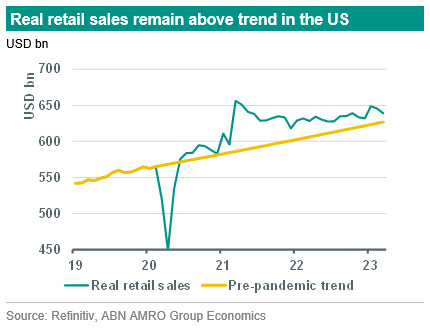US consumer remains resilient, for now

Retail sales cooled in March, but the fall was only marginal compared with the surge in January and February
Retail sales cooling, but very gradually
US nominal retail sales fell by 1% m/m in March, though the bulk of this was driven by falling gasoline prices (which fell 4.6% m/m, according to Wednesday’s CPI data). ‘Core’ retail sales, i.e. excluding gasoline & autos, fell by a much more modest 0.3% m/m. The March decline is a drop in the ocean following the 2.8% surge in core retail sales over January and February. Indeed, the details showed continued solid growth in online sales with only modest declines in some categories, such as apparel, which is normalising from the post-pandemic catch-up phase. Eating out also remained strong, suggesting resilient demand in the face of significant recently.

Consumption likely to weaken in Q2
While the preliminary reading on Michigan consumer sentiment rose somewhat today, to 63.5 from 62 in March, it remains at relatively low levels, with consumers continuing to cite the hit to their finances from high inflation. Meanwhile, high frequency indicators such as Redbook’s weekly general merchandise store data indicate that retail sales at bricks & mortar shops continued to soften moving into April. With the pickup in the savings rate suggesting consumers are increasingly unwilling or unable to deploy excess savings to maintain consumption in the face of high inflation, and tighter financial conditions (including from the recent banking turmoil) likely to continue bearing down on activity more broadly, we expect consumption to weaken more meaningfully in the second quarter, when we expect a contraction in GDP. For Q1, however, the US economy has continued to perform with resilience in the face of headwinds.
